Easy CrossFit Exercises You Can Do At Home

CrossFit is a high-intensity conditioning program that involves functional movement strength, and it’s constantly varying. It’s seen tremendous growth in popularity all around the world since its inception. Here are some easy CrossFit exercises that you can do at home!
Despite the criticism regarding possible injuries associated with this type of training, the injury rates are similar to those in other sports such as Olympic weightlifting, general weightlifting, and gymnastics. Therefore, there’s no reason to be afraid of this sport.
Easy CrossFit exercises to work out at home
Taking into the account the current world situation, in which people from many countries have the obligation to stay at home, here are some easy CrossFit exercises to do indoors.
Air squat or weightless squat
The squat is one of the most basic and comprehensive exercises in strength training. This is the procedure to carry it out:
- Starting position: stand up and spread your feet shoulder-width apart; point your toes slightly outward.
- Eccentric phase: it starts by descending, bringing the hips back and down, at the same time that you flex your knees until the hips are at knee level. If you accompany this movement with your arms, you can achieve greater stability. To do this, you have to lift your arms at shoulder level when you descend.
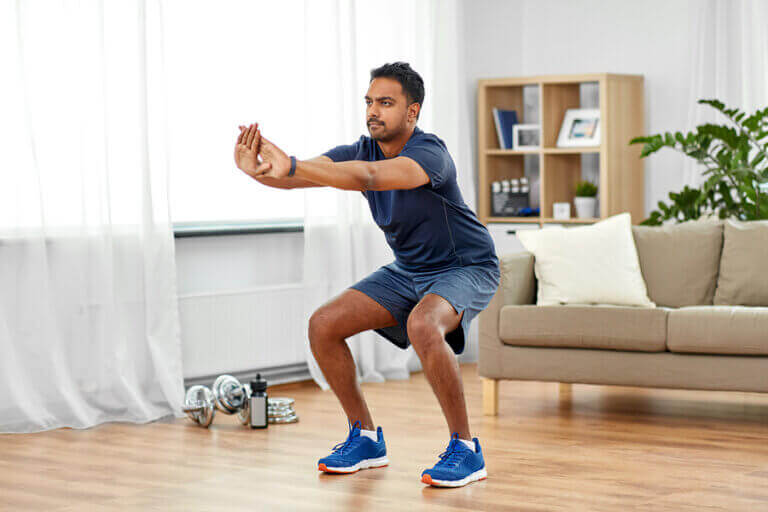
- Concentric phase: push up with your legs, extending the hips and knees. Lower your arms until they’re parallel to your body.
Lastly, we also have some tips to get the right form:
- Face forwards throughout the movement.
- Don’t raise your heels.
- Keep your chest elevated.
- Keep the back straight: you have to respect the natural line of your spine.
Sit-ups or crunches
When doing this exercise, it’s very important to make controlled movements. Since it’s an exercise in which you use the inertia of your arms, you must activate your abs well to avoid lumbar hyperlordosis.
- Starting position: lay on a mat. Then bend your knees and bring the soles of your feet together. Place your arms back and extend them to increase the lever arm.
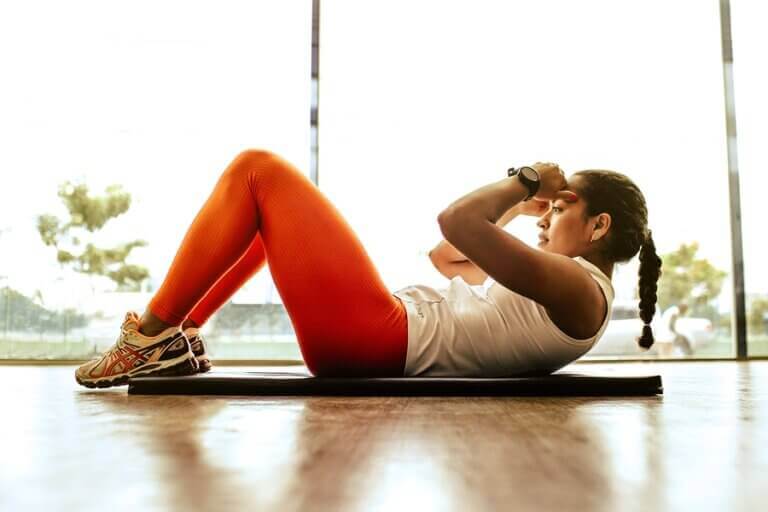
- Concentric phase: flex your core and use the inertia of your arms until you touch your feet with your hands. You must control this movement to avoid causing any injuries.
- Eccentric phase: extend your spine again while bringing back your arms.
Push-ups
- Initial position: lay face down with your body extended. Place your hands below your shoulders to support your body; you should keep your elbows extended. Have your fingers point towards the front and keep your head aligned with your back. It’s important to activate your abs properly.
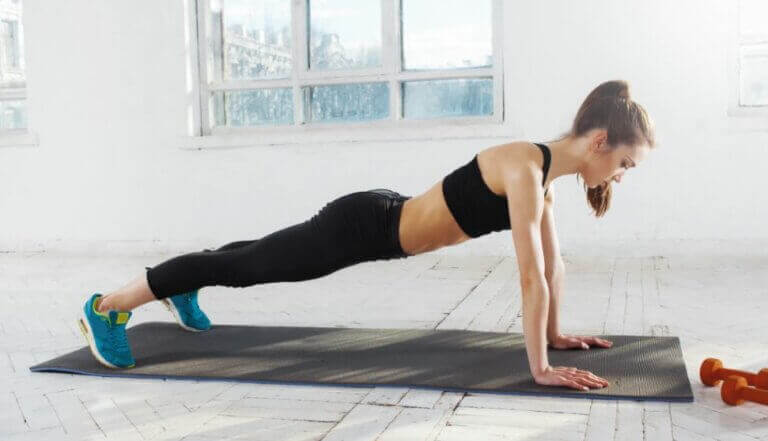
- Eccentric phase: bring the chest closer to the ground. To do this, flex your elbows; at this point, it’s important that you flex your elbows backward, close to your body, and not horizontally. It’s also important to breathe in during this phase.
- Concentric phase: push against the floor until you extend your arms again. In the concentric phase, you must breathe out when performing the movement.
The following keys will help you to do this exercise correctly:
- Your forearms must remain vertical.
- You must activate your glutes and abs. This way, you’ll be able to perform a hip retroversion and you’ll also protect your back.
Burpees: the basics of easy CrossFit exercises
Burpees are one of the quintessential CrossFit exercises. To perform them, it’s important to keep your core engaged during the eccentric phase. You must also keep your back aligned from the beginning of the squat.
- Starting position: stand up.
- Eccentric phase: first, descend by squatting until you can touch the floor with your hands. Subsequently, bring your feet back with a jump, placing your body in a horizontal position and going down. Bring your chest close to the floor, as you would during the eccentric phase of the push-up.

- Concentric phase: as a first step, push against the floor, extending your elbows. Then, bring both feet forward with a jump until they’re at the same level as your hands. Extend your body as you would do in the concentric phase of the squat. To finish, clap your hands over your head.
Mountain climbers
Before starting, it’s important to consider that you have to have a good activation of your abs and avoid hip anteversion to perform mountain climbers.
- Initial position: face downwards, extend your body and support your weight with only your hands and feet. You should extend your arms and engage your core.
- First phase: lift one foot and bring the knee close to your chest.
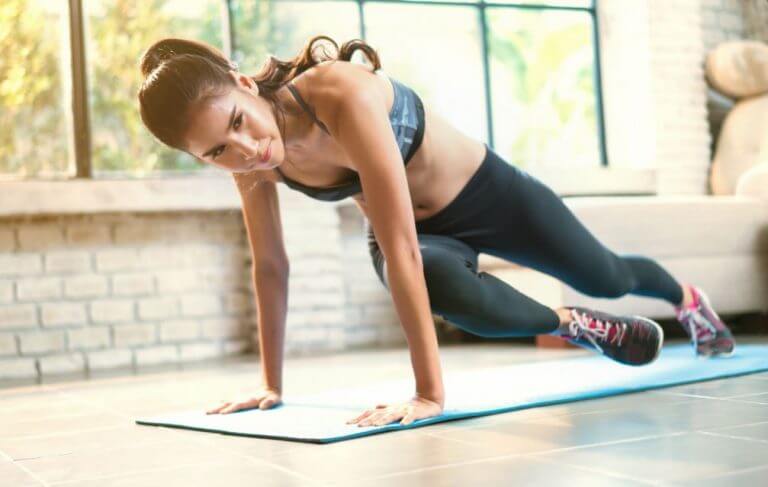
- The second phase: perform a leg extension to return to the starting position. Then, repeat the same movement with your other leg.
Handstand push-up
Before performing this exercise, you must be able to hold the starting position for at least 60 seconds. If you don’t have healthy and trained shoulders, it’s better to avoid handstand push-ups, since they require lifting almost all of your body weight with the muscles located around this joint.
- Starting position: a handstand against the wall.
- Eccentric phase: bring the body down, flex your elbows while staying in a vertical position.
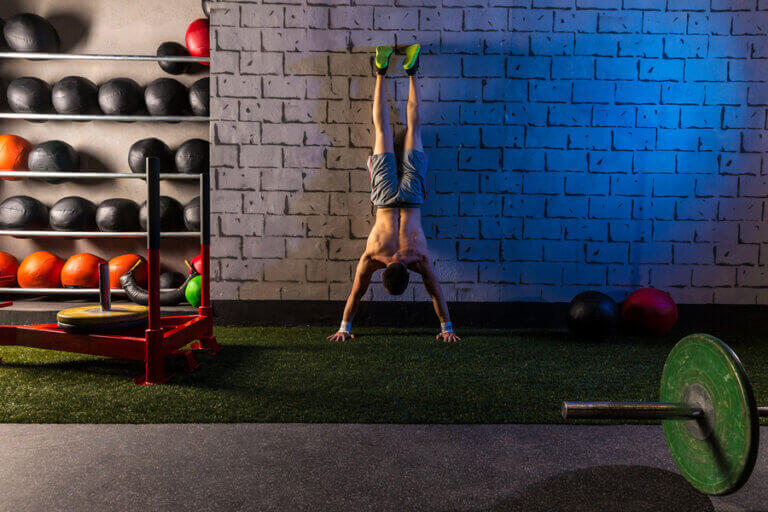
- Concentric phase: push back to lift up your body until you’re at the starting position again.
Easy CrossFit exercises: the best ally during isolation
Besides improving your body composition, CrossFit training is all the motivation that you need to continue working out during quarantine. Take advantage of this exercise to stay active!
CrossFit is a high-intensity conditioning program that involves functional movement strength, and it’s constantly varying. It’s seen tremendous growth in popularity all around the world since its inception. Here are some easy CrossFit exercises that you can do at home!
Despite the criticism regarding possible injuries associated with this type of training, the injury rates are similar to those in other sports such as Olympic weightlifting, general weightlifting, and gymnastics. Therefore, there’s no reason to be afraid of this sport.
Easy CrossFit exercises to work out at home
Taking into the account the current world situation, in which people from many countries have the obligation to stay at home, here are some easy CrossFit exercises to do indoors.
Air squat or weightless squat
The squat is one of the most basic and comprehensive exercises in strength training. This is the procedure to carry it out:
- Starting position: stand up and spread your feet shoulder-width apart; point your toes slightly outward.
- Eccentric phase: it starts by descending, bringing the hips back and down, at the same time that you flex your knees until the hips are at knee level. If you accompany this movement with your arms, you can achieve greater stability. To do this, you have to lift your arms at shoulder level when you descend.

- Concentric phase: push up with your legs, extending the hips and knees. Lower your arms until they’re parallel to your body.
Lastly, we also have some tips to get the right form:
- Face forwards throughout the movement.
- Don’t raise your heels.
- Keep your chest elevated.
- Keep the back straight: you have to respect the natural line of your spine.
Sit-ups or crunches
When doing this exercise, it’s very important to make controlled movements. Since it’s an exercise in which you use the inertia of your arms, you must activate your abs well to avoid lumbar hyperlordosis.
- Starting position: lay on a mat. Then bend your knees and bring the soles of your feet together. Place your arms back and extend them to increase the lever arm.

- Concentric phase: flex your core and use the inertia of your arms until you touch your feet with your hands. You must control this movement to avoid causing any injuries.
- Eccentric phase: extend your spine again while bringing back your arms.
Push-ups
- Initial position: lay face down with your body extended. Place your hands below your shoulders to support your body; you should keep your elbows extended. Have your fingers point towards the front and keep your head aligned with your back. It’s important to activate your abs properly.

- Eccentric phase: bring the chest closer to the ground. To do this, flex your elbows; at this point, it’s important that you flex your elbows backward, close to your body, and not horizontally. It’s also important to breathe in during this phase.
- Concentric phase: push against the floor until you extend your arms again. In the concentric phase, you must breathe out when performing the movement.
The following keys will help you to do this exercise correctly:
- Your forearms must remain vertical.
- You must activate your glutes and abs. This way, you’ll be able to perform a hip retroversion and you’ll also protect your back.
Burpees: the basics of easy CrossFit exercises
Burpees are one of the quintessential CrossFit exercises. To perform them, it’s important to keep your core engaged during the eccentric phase. You must also keep your back aligned from the beginning of the squat.
- Starting position: stand up.
- Eccentric phase: first, descend by squatting until you can touch the floor with your hands. Subsequently, bring your feet back with a jump, placing your body in a horizontal position and going down. Bring your chest close to the floor, as you would during the eccentric phase of the push-up.

- Concentric phase: as a first step, push against the floor, extending your elbows. Then, bring both feet forward with a jump until they’re at the same level as your hands. Extend your body as you would do in the concentric phase of the squat. To finish, clap your hands over your head.
Mountain climbers
Before starting, it’s important to consider that you have to have a good activation of your abs and avoid hip anteversion to perform mountain climbers.
- Initial position: face downwards, extend your body and support your weight with only your hands and feet. You should extend your arms and engage your core.
- First phase: lift one foot and bring the knee close to your chest.

- The second phase: perform a leg extension to return to the starting position. Then, repeat the same movement with your other leg.
Handstand push-up
Before performing this exercise, you must be able to hold the starting position for at least 60 seconds. If you don’t have healthy and trained shoulders, it’s better to avoid handstand push-ups, since they require lifting almost all of your body weight with the muscles located around this joint.
- Starting position: a handstand against the wall.
- Eccentric phase: bring the body down, flex your elbows while staying in a vertical position.

- Concentric phase: push back to lift up your body until you’re at the starting position again.
Easy CrossFit exercises: the best ally during isolation
Besides improving your body composition, CrossFit training is all the motivation that you need to continue working out during quarantine. Take advantage of this exercise to stay active!
All cited sources were thoroughly reviewed by our team to ensure their quality, reliability, currency, and validity. The bibliography of this article was considered reliable and of academic or scientific accuracy.
- Hak, P. T., Hodzovic, E., & Hickey, B. (2013). The nature and prevalence of injury during CrossFit training. Journal of strength and conditioning research.
- Schultz, J. T., Parker, A., Curtis, D., Daniel, J., & Huang, H. H. (2016). The physiological and psychological benefits of CrossFit training–a pilot study. In International journal of exercise science: conference proceedings (Vol. 2, No. 8, p. 14).
This text is provided for informational purposes only and does not replace consultation with a professional. If in doubt, consult your specialist.








